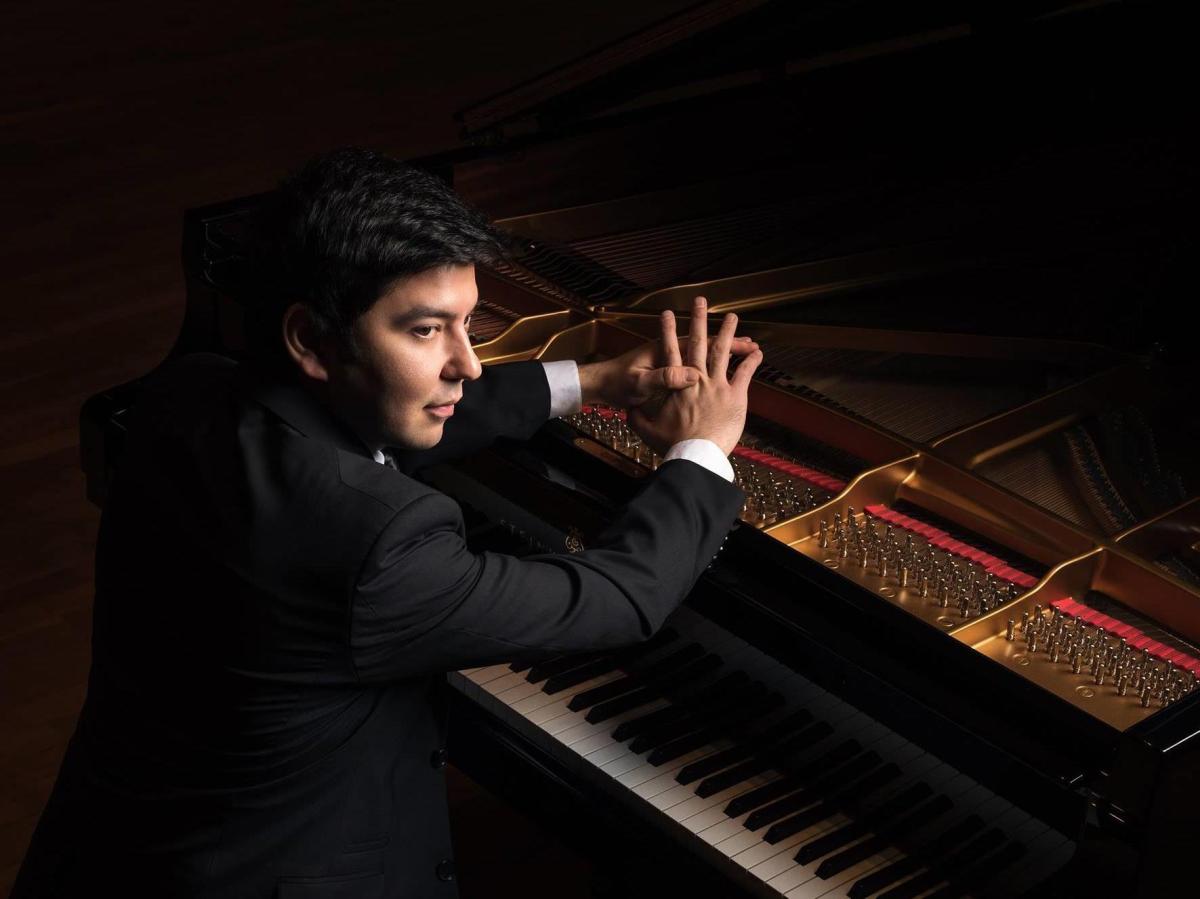Behzod Abduraimov on piano. Image supplied.
Perth Concert Hall was the first concert hall to be built in Australia after World War Two. As well as some of the finest acoustics in the southern hemisphere, it has something that even the great Hamer Hall in Melbourne doesn’t have and that is 160 seats behind the orchestra, called choir stalls. The choir stalls give an inclusive view of the musicians and their instruments as well as the conductor and are not so heavy on the pocket, especially for those with children.
But it is behind-the-scenes organisation of programs like Rachmaninov’s Rhapsody that makes Perth Concert Hall so special. A 20-minute talk by répétiteur, Philip A. Robertson, before the concert started, included excerpts which gave an idea of the joy which was to follow. Not just one Russian composer but three, Tchaikovsky, Rachmaninov and Stravinsky who, nearly 200 years ago, would have exchanged ideas, a love of stories, music and ballet to deliver a masterpiece, each in his own particular way. Some were influenced by Rimsky-Korsakov, Stravinsky by the great ballet impressario, Diaghilev and Tchaikovsky by Shakespeare’s words written 300 years earlier.
A great story, put to music, can move you through a gamut of emotions and, from the trumpet’s sombre opening of The Tempest, Tchaikovsky skilfully brought in the French horns, then oboes, scaling up to percussion, violins, cellos, basses, cymbals until the whole orchestra erupted like the roaring ocean that Prospero had magically generated to wreck the boat on which his daughter, Miranda, his treacherous brother, Antonio and the King of Naples and his son, Ferdinand, were travelling.
Just as dramatically, calm was instantly restored by the elegant, soothing arms of guest conductor, Spaniard Jaime Martin, as he drew the wistful songs of Ariel, Prospero’s spirit, from Andrew Nicholson’s flute, willing Miranda and Ferdinand to fall in love.
In a generous talk after the concert, Martin gave us a view into his own magical career including the years he had spent playing Principal Flute before he became a conductor.
While Tchaikovsky and Stravinsky had a mutual interest in magic and puppetry, Rachmaninov’s imagination had been captivated by the works of Italian, Nicolo Paganini, considered to be the greatest violinist of the 19th century.
Rachmaninov chose Paganini’s 24th Caprice on which to write 24 variations specifically for piano and orchestra as one movement called a concertante. A tall man with enormous hands that had a far greater stretch than average, Rachmaninov, himself a talented pianist, had been nervous about playing this complicated work at its premiere in 1934. With that in mind, the performance by Behzod Abduraimov from Tashkent, small in stature and only 29 years of age, was even more stunning.
From the opening chords, at times he seemed to have to reach right over the keys to get the force he needed but he nailed it with a relish and passion that made you catch your breath. The work is as demanding for the orchestra as it is for the soloist and, at times, it felt as though it were a race run a little too fast but how do you stop a runaway horse? While Abduraimov certainly kept apace, a slightly more restrained accompaniment from the orchestra would still have worked well. Nevertheless, with amazing arpeggios and trills, Abduraimov took us to a rapturous high before joining with the violins to deliver Paganini’s famous theme which tears at the heart. There would be few who could play it as magnificently as Abduraimov did, bringing the capacity audience to its feet, clapping, whistling, cheering for more til, after the third encore, they finally got it and what a gift it was! Franz Liszt’s La Campanella! Paganini would have been proud.
Interval and time to move the piano in preparation for a different story with Graeme Gilling tinkling the ivories to bring puppet, Petrushka to life with the ballerina and the Moor.
These complex characters created a challenge for the orchestra which transported the audience immediately to all the fun of the 1830 Shrovetide Fair in St Petersburg. Trumpets heralding, horns, tuba, kettle drums thundering, castanets, all interspersed with a beckoning flute solo, bird whistles and the melodious hurdy-gurdy sound of the xylophone. Unfortunately, like many good love stories, after the exaltation comes jealousy and a destructive downward spiral but what an opportunity for solo musicians like Brent Grapes on trumpet and, alongside him, a female trumpeter, Jenna Smith. At the same time who can express the heartache of love’s ups and downs more beautifully than the wind section along with piccolo and flute? The restrained pauses gave soloists time to shine and brought the whole work home triumphantly, if slightly deflated after the Rachmaninov.
The WASO never disappoints because it is a cohesive force. It brings to mind a quotation by John Donne that has also stood the test of time.
‘No man is an island entire of itself; every man is a piece of the continent, a part of the main…’
Rachmaninov’s Rhapsody
Western Australia Symphony Orchestra
TCHAIKOVSKY – The Tempest
RACHMANINOV’S Rhapsody on a Theme of Paganini
STRAVINSKY – Petrushka
Conductor – Jaime Martin
Piano – Behzod Abduraimov
5 April 2019
Perth Concert Hall





